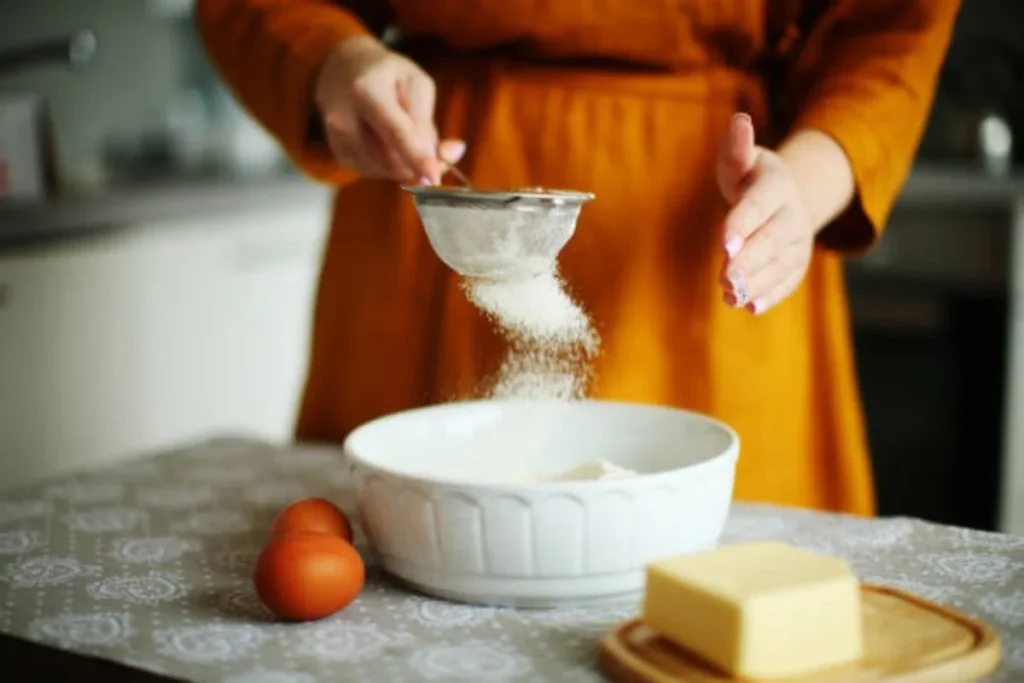
Can You Use Cookie Mix to Make a Cake? Let’s Find Out!
People who love baking are always trying new things in the kitchen. One question that comes up a lot is whether you can use cookie mix to make a cake. Even though cookies and cakes are different, the idea of using cookie mix for a cake is interesting.
In this blog post, we’ll check out if it’s possible, talk about the differences between cookie and cake mixes, and give you a simple guide to try it out yourself.
Table of Contents
ToggleIs Cookie Mix The Same As Cake Mix?
Cookie mix and cake mix are both baking mixes, but they’re made for different things and have different stuff in them. Cookie mix is for making cookies and usually has flour, sugar, baking soda or powder, and sometimes chocolate chips or nuts.
Cake mix, on the other hand, is for making cakes. It usually has flour, sugar, baking powder, and sometimes cocoa powder for chocolate cakes. You might need to add eggs, oil, and water to the cake mix to make it right.
Challenges Of Using Cookie Mix to Make a Cake
Using cookie mix to bake a cake sounds fun, but it’s not without its challenges. When you’re trying this baking experiment, there are a few things to keep in mind to make sure your cake turns out just right.
Let’s talk about some of the hurdles you might face:
1. Texture and Consistency: Cookies and cakes feel different when you bite into them. Cookies are chewy and dense, while cakes are soft and fluffy. Getting the right balance can be tricky when you’re using cookie mix because it’s meant for cookies, not cakes. You’ll need to add things like baking powder and milk to make the texture more cake-like.
2. Leavening Agents:: Cookie mixes usually have stuff in them to make them rise a bit, but cakes need more help to puff up. Adding baking powder is key to getting that rise, but you’ve got to be careful not to use too much or too little. Too much and your cake might get too puffy and fall apart, while too little can make it dense and flat.
3. Moisture Content: Cookies are a bit drier to help them keep their shape, but cakes need moisture to stay soft and tender. Adding some milk to your cookie mix will help keep your cake from getting dry and crumbly.
4. Flavor Profile: Cookie mixes often come with flavors like chocolate chips or vanilla, which might not work perfectly in a cake. Adding a bit of vanilla extract can help enhance the taste without messing with the cookie flavor too much.
5. Baking Time and Temperature: Cookies and cakes bake at different times and temperatures because they have different thicknesses and textures. Finding the right balance to bake your cake all the way through without drying it out too much can be tricky. Keep an eye on it and use the toothpick test to make sure it’s done just right.

How to Make Easy Cookie Mix Cake | Step-by-Step
For folks just starting with baking, turning a cookie mix into a cake might seem pretty intimidating. But don’t worry! This guide is here to walk you through making a simple cookie mix cake, making it easy and fun even if you’re new to baking.
Ingredients:
- 1 box of your favorite cookie mix
- Additional ingredients listed on the cookie mix box (usually eggs, butter, etc.)
- 1 cup of milk
- 1 teaspoon of baking powder
- 1 teaspoon of vanilla extract (optional)
Instructions:
Step 1: Get the Oven Ready Start by preheating your oven to the temperature on the cookie mix box. This helps your cake cook evenly and come out just right.
Step 2: Mix Up the Cookie Dough Follow the directions on the cookie mix box to make the cookie dough. Usually, you’ll mix the cookie mix with stuff like eggs and butter. Just stick to the amounts on the box for the best results.
Step 3: Add Baking Powder To make your cookie dough more cake-like, add 1 teaspoon of baking powder. This helps give your cake a nice, fluffy texture.
Step 4: Add Milk Slowly pour 1 cup of milk into your cookie dough. This is important to make sure your cake is moist and yummy.
Step 5: Maybe Add Vanilla If you want to add some extra flavor, you can put in 1 teaspoon of vanilla extract. It’s optional, but it can make your cake taste even better.
Step 6: Mix It Up Use a whisk to mix everything really well. Make sure the baking powder, milk, and vanilla (if you used it) get evenly mixed in. Your batter should be smooth and consistent.
Step 7: Prep the Cake Pan To keep your cake from sticking, grease your cake pan with cooking spray or line it with parchment paper. This step is important to make sure your cake comes out easily.
Step 8: Pour in the Batter Put your mixed batter into the prepared cake pan. Use a spatula to smooth out the top so it’s all even.
Step 9: Bake Like the Cookie Mix Says Pop your cake pan into the preheated oven and bake it according to the instructions on the cookie mix box. Keep an eye on it as it bakes and use the toothpick test to check if it’s done.
Step 10: Cool and Enjoy Once your cake is done baking, let it cool in the pan for a bit before moving it to a wire rack to cool completely. Then, slice it up and enjoy your tasty creation!

Common Mistakes To Avoid When Using Cookie Mix For Cake Baking
When utilizing cookie mix to create a cake, it’s important to be mindful of common mistakes that can potentially impact the final outcome. Here are some common mistakes to avoid when using cookie mix for cake preparation:
1. Disregarding Cookie Mix Instructions:
One prevalent mistake is neglecting the instructions provided on the cookie mix box. While the aim is to transform the mix into a cake, the foundational elements of the cookie should not be overlooked.
Pay attention to recommended quantities of eggs, butter, and other ingredients. These ratios contribute to the cookie’s texture, and altering them haphazardly may lead to an undesirable cake consistency.
Tip: Treat the cookie mix instructions as a baseline and make adjustments accordingly, keeping in mind the additional ingredients needed for a cake-like texture.
2. Overmixing the Batter
Overenthusiastic mixing can be a downfall when using cookie mix for a cake. Unlike cookies that benefit from a slightly denser texture, cakes thrive on lightness.
Overmixing can lead to a tough and dense cake due to the excess development of gluten in the batter. To achieve a soft and fluffy cake, gently combine the ingredients until just incorporated.
Tip: Use a light hand when mixing, and stop as soon as the ingredients are blended. A few lumps in the batter are acceptable and will not compromise the final result.
3. Ignoring Additional Leavening Agents
While the cookie mix may already contain baking powder or soda, it might not be sufficient to achieve the desired cake-like rise.
Neglecting to add extra leavening agents, such as baking powder, can result in a flat and dense cake. Ensure the cake batter has enough lift to produce a light and airy texture.
Tip: Follow the recipe’s suggestion to incorporate additional leavening agents like baking powder. This ensures a well-risen and pleasantly textured cake.

4. Neglecting Moisture Content
Cakes, more than cookies, require a higher moisture content to achieve a tender crumb.
Neglecting to add sufficient liquids like milk can result in a dry and unappetizing cake. The milk not only contributes to the moisture but also aids in achieving the desired cake consistency.
Tip: Be mindful of the moisture content in the batter. If the cookie mix instructions do not include liquids, consider adding milk to the cake batter to enhance both texture and flavor.
5. Skipping the Toothpick Test
A common mistake bakers often make is forgetting to do the toothpick test when baking. Just relying on the suggested baking time can result in a cake that’s either undercooked or overcooked.
Insert a toothpick into the center of the cake; if it comes out clean or with a few moist crumbs, the cake is done. If the batter sticks to the toothpick, it needs more baking time.
Tip: Trust your senses and the toothpick test over the clock. Every oven is different, and factors like altitude can influence baking times.
6. Forgetting About Flavor Enhancement
While the primary focus is on the transformation from cookie to cake, neglecting flavor enhancement can result in a bland dessert. Adding vanilla extract or other flavorings can elevate the taste and contribute to a more well-rounded cake.
Tip: Don’t be afraid to experiment with flavors. Consider adding vanilla extract, citrus zest, or other extracts to enhance the overall taste of your cookie mix cake.
7. Impatience During Cooling
The excitement of creating a cookie mix cake may lead to impatience when it comes to cooling. Removing the cake from the pan too quickly can cause it to crumble or lose its shape. Proper cooling ensures the cake sets and maintains its structure.
Tip: Allow the cake to cool in the pan for the recommended time before transferring it to a wire rack. Patience pays off in the form of a beautifully intact cake.
Conclusion
In conclusion, using cookie mix to make a cake is not only possible but also a fun and delicious experiment. By combining the elements of both cookie and cake mixes, you can create a unique dessert that offers the best of both worlds.
Whether you’re a baking enthusiast looking for a new challenge or someone with a sweet tooth craving a one-of-a-kind treat, give this recipe a try and indulge in the delightful experience of a cookie mix cake. Happy baking!
Lindsey Mackenzie
About me
Hi there! I’m Lindsey Mackenzie, the founder of Bake Smartly. Baking has been my passion since childhood, growing up in my father’s bakery. With Bake Smartly, I’m excited to share my love for all things sweet and savory. Join me on this delicious journey as we whip up scrumptious treats and sprinkle joy into every bite!






